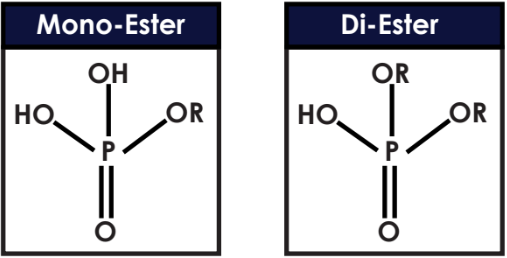Enhanced TDS
Identification & Functionality
- Chemical Family
- Cleaning Ingredients Functions
- Fluids & Lubricants Functions
- Industrial Additives Functions
- Technologies
- Product Families
- Chemical Structure of Phosphate Esters

Features & Benefits
- Labeling Claims
- HII Features
- Industrial Additives Features
- General Properties of Phosphate Esters
- Alkali Stability and Solubility
- Coupling and Emulsification
- Detergency and Rinse-ability
- Increased Hard Water Tolerance
- Corrosion Inhibition
- Lubricity
- Wetting
- Thermal Stability
- Background on Phosphate Esters
- Phosphate Esters are anionic surface active agents produced by reacting polyphosphoric acid or phosphorous pentoxide with molecules containing hydroxyl groups - commonly ethoxylated moieties or alcohols. Reactions using phosphorous pentoxide result in a mix of mono and di-esters, while products made with polyphosphoric acid are high in mono-ester yield.
- Which type to use depends upon the properties needed in formulation. Mixed esters products are generally better for emulsification; whereas, mono- ester rich exhibit better hydrotroping properties.
Applications & Uses
- Markets
- Applications
- Fluids & Lubricants Type
- Fluids & Lubricants End Use
- Home Care Applications
- I&I Cleaning Applications
- Industrial Additives End Use
Properties
- Physical Form
- Soluble In
- Appearance
- Yellow liquid
- Soluble in
- Water, Ethanol, Xylene
- Compatible with
- Anionic Surfactant, Nonionic Surfactant
- Insoluble in
- Mineral oil, Kerosene, Perchloroethylene
- Typical Properties
Value Units Test Method / Conditions Caustic Solubility (in 18% NaOH at 25°C) 18.8 - - Activity 98.5 % Color max. 9 - Gardner Flash Point min. 300 °F Pensky Martens Closed-Cup Moisture Content max. 1.5 % - pH (at 1% aqueous Solution) 1.8 - 2.5 - - Pour Point 40.0 °F - Acid Value (at pH 5.5) 120.0 mg KOH/g - Specific Gravity (at 68°F) 1.1 - - Weight (at 68°F) 9.2 lbs/gal - Surface Tension (at 0.05% Aqueous at 77°F) 30.8 dynes/cm - Cloud Point (at 1% in 18% NaOH Aqueous) min. 95 °F - Hydrophobe Linear Alcohol Ethox - Compatibility
This product should not be mixed with concentrated oxidizing agents or reducing agents, as the mixture of these compounds with organic compounds form a potentially explosive mixture.
Regulatory & Compliance
- Certifications & Compliance
- Chemical Inventories
Packaging & Availability
- Supplied by
Storage & Handling
- Storage & Handling Information
- T-Mulz 810 is regarded as corrosive and should be handled as such.
- It should not be used in products for internal use.
